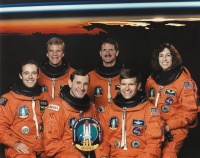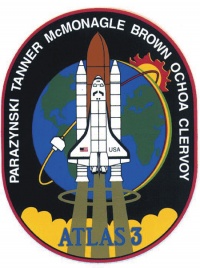STS-66
From The Space Library
 | |
| Organization | NASA-Office of Space Flight (United States) |
|---|---|
| Mission type | Human Crew |
| Launch date | November 3, 1994 |
| Launch vehicle | Space Shuttle |
| Launch site | Cape Canaveral, United States |
| COSPAR ID | 1994-073A |
| Inclination | 57 degrees |
| Experiments | Here |
| Alternate Names | 23340 |
| Additional Information | Here |
| Data Collection | Here |
| Payload Mass Up | 10544 kg |
| Payload Mass Down | 10566.82 kg |
| Orbiter | Atlantis |
| Lift Off Mass | 2,049,258.64 kg |
| Orbiter Weight at Liftoff | 110,835.91 kg |
| Orbiter Weight at Landing | 95,382.73 kg |
| Landed | Concrete runway 22 at Edwards Air Force Base, Calif. |
| Orbits of Earth | 174 |
| Orbital Altitude | 164 nautical miles (189 statute miles) |
Contents |
[edit] Crew
- Commander: Donald R. McMonagle
- Pilot: Curtis L. Brown Jr.
- Payload Commander: Ellen Ochoa
- Mission Specialist 1: Scott E. Parazynski
- Mission Specialist 2: Joseph R. Tanner
- Mission Specialist 3: Jean-Francois Clervoy, European Space Agency
- Mission Specialist 4:
- Mission Specialist 5:
- Payload Specialist 1:
- Payload Specialist 2:
ISS/Mir Crew Transport
[edit] Mission
[edit] EVA
[edit] Payload
Atmospheric Laboratory for Applications and Science (ATLAS) 3; Cryogenic Infrared Spectrometers and Telescopes for the Atmosphere (CRISTA)-Shuttle Pallet Satellite (SPAS) 1; Experiment of the Sun for Complementing the ATLAS Payload for Education (ESCAPE) II; Inter-Mars Tissue Equivalent Proportional Counter (ITEPC); Shuttle Solar Backscatter Ultraviolet (SSBUV) A; Physiological and Anatomical Rodent Experiment (PARE/NIH-R); Protein Crystal Growth (PCG-TES and PCG-STES); Space Tissue Loss (STL/NIHC-A); Shuttle Acceleration Measurement System (SAMS); Heat Pipe Performance (HPP)
[edit] Books about the Space Shuttle Program
Buy This Book Click here |
Buy This Book here |
Buy This Book Click here |
Buy This Book Click here |





